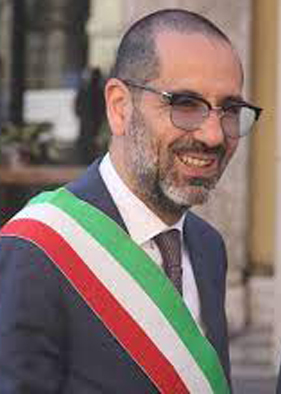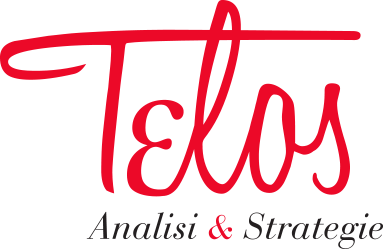May 2021, Year XIII, no. 5
Leonardo Latini
The Green Mayor
"What I regret is that the pandemic prevented me from being with my people over these months. I count on making up for this soon precisely because I believe that in order to restore perspective to politics, we need to bridge the gap between politicians and the community."
Telos: Every time someone talks about the direct election of the Prime Minister, people use the very evocative expression “Mayor of Italy”. So, is it true that Mayors have, in the administration of their own city, more power than the Prime Minister has today?
Leonardo Latini: Public affairs are handled on two very different levels. Clearly, the more the administration distances itself from the local area, the more it has to step in with general measures. You ask me which level has more power… We need to clarify what it means to exert power. In the second post-war period, Adriano Olivetti proposed a central government model based on local communities. He argued that the ideal size of each community, and therefore of each administrative body, should be no more than 100,000 inhabitants. In a community of this size, he said, there could still be participation, control and effective management. Any larger, and everything gets more complicated.
So yes, if we understand power as the ability to impact directly and specifically a community’s necessities, needs and expectations, this would lead us to think that this power is more easily exerted by a Mayor in a small- to medium-sized city rather than by the Prime Minister of an entire country.
But this is only theory, because, in reality, we local administrators increasingly feel like our hands are tied by ropes and chains put on us from above and, what’s more, we feel frustrated because we collect the problems and concerns of our fellow citizens, because we are on the frontline. So, the job of the mayors and local administrators should also be, actually should mainly be, to represent the needs of the territory before the higher levels of public administration. The duty of governments and higher bodies should be to listen to local administrators and heed their advice and demands, because the connection between the central government and the local area is essential. Also, or better, mainly in terms of the distribution of resources which should be inspired by real principles of subsidiarity. Therefore, the Prime Minister – excuse the joke – more than the Mayor of Italy, should be the Mayor of Mayors...
The breakdown in the party system has very likely been the source of people’s widespread anti-political sentiment. And yet this gap between citizens and politics is not nearly as wide when it comes to the Mayor. Are your citizens still passionate about politics?
I am a mayor from the League party. The experience of the League was historically born of the attempt to mend the relationship between citizens and politics, between the people and politics, as well as between the local territory and the bodies that represent them at all levels.
This is what I’ve been and still am the most passionate about, also considering my personal political and cultural education. This is why I am happy to be the Mayor and to be a mayor for the League in this particular moment in history, because the challenge has never been more open, it has never been more important to keep communities united, to make citizens feel like they are part of something, to reinforce an identity, achieve a goal, build a participatory and shared future. Unfortunately – or fortunately, who knows – the public institutions, especially the local institutions, no longer have same funds available that they did in the past.
For now, we need to broaden participation and subsidiarity as well as involve citizens, associations and the business world. This is why it is our job to re-ignite political passion, in a broad sense, in the city. What I regret is that the pandemic prevented me from being with my people over these months. I count on making up for this soon precisely because I believe that in order to restore perspective to politics, we need to bridge the gap between politicians and the community. Regarding my city, Terni, I am well aware of the fire burning beneath the superficial disillusionment and disappointment that has built up over recent decades and I am ready to make sure this energy is not wasted.
This is your first time as public administrator and being the Mayor certainly is not easy, especially in a city that for 19 years in a row had an administration of a different political part. What obstacles did you not expect to face and what, instead, made a more positive impression?
I knew, we knew, that we would have to run the city of Terni during a very tough crisis, also because we inherited an institution that had been declared to be bankrupt, with all the consequences imposed by law, which also forced us to have to govern along with an Extraordinary Liquidation Body which, in fact, handled the liquidation of accumulated debts.
But what we didn’t know was that, in addition to this, to having to handle a crisis of the city’s industrial system that had been going on for more than ten years, we would have to also deal with the economic effects of the pandemic.
But this is the situation and we have learned that you have to cope with emergencies with courage and, especially, with vision.
You have been the Mayor of Terni for three years now. You took office on 26 June 2018, and now is time to take stock of what you have done but with still enough time to do a lot more. What do you see yourself doing over the next two years?
The National Plan of Resilience and Recovery (NPRR) is indeed a very important opportunity that we have tried to seize with great determination by presenting 23 projects for Terni. However, the ideas and projects certainly did not come out of nowhere, nor were they envisioned exclusively for the Plan. Instead, they are projects that fit right into our vision of the city. A vision we have been furthering since the beginning of our term: a greener, smarter and more innovative city and – in general – more dynamic and attractive. With the NPRR – trusting that the resources arrive – we will be able to get our ideas up and running far more quickly. It is no coincidence that, of the projects we are focussing on, many regard digitalisation.They will help improve the services of the public administration by making citizens’ lives easier. They will also be useful to facilitate economic activities and local businesses. Among all the negative effects of the pandemic, one thing it taught us is actually how to best use new technologies to optimise office activities in terms of organisation and procedures and to provide cheaper and more efficient services. And this needs to be sped up considerably. Naturally, we will continue to look for ways to support our projects besides just the NPRR using any line of financing, whether it be through the Regions, Ministries or the EU.
For example, this is what happened with the Hydra project for mobility and hydrogen, which was thought to be strategic even at the national level. So, in this sector, like the electric mobility sector, Terni is on the cutting edge, and even ahead of the line of the government recently announced by Prime Minister Mario Draghi. Sustainable mobility and the ecological transition are massive, worldwide challenges, but – if I may – they are even more challenging for Terni. In general, we think a greener Terni not only means a less polluted city, but also a city with a better quality of life and therefore more attractive. A more intelligent Terni, with more innovative services, more space for research – like the scientific hub we are planning – and better inserted into the greater transition processes. Terni has to once again be a city that can offer jobs and opportunities for young people.
The other big project regards the creation of infrastructure to ensure the city is more attractive to the sports and entertainment industry. We are finally building a large sports facility that we have designed to be an all-purpose facility suitable for concerts and performances.
We are already quite far along in building new bike paths and cycle lanes that will connect the city to its marvellous surrounding areas, to Valnerina, Spoleto and Assisi and to the Narni Gorge and then Rome. We want our main tourist attraction, the Marmore Falls, to have new infrastructure that is environmentally friendly, by building a lift and navigation system that connects to Piediluco Lake.
So, there is a lot to do, and a lot of projects that are already underway. All with one common denominator: make sure that Terni is once again on the cutting edge as it was for many years in Umbria and Italy and that it is once again proud of its roots and of its quality of life.
In short, we have to play offence, like our local football team, Ternana, which triumphed at the championships this year…
Marco Sonsini
Editorial
When you think about Terni, you think about steel, about the crisis of industry. And what about Terni and sweet pizza? However, for the man we’ve interviewed this month, Mayor Leonardo Latini, the first things that have to come in one’s mind have to be employment, respect for the environment and sports tourism.
It’s not that Terni’s well-known sweet pizza should be undermined. Instead, perhaps it’s more pressing for Latini to imagine associating Terni with hydrogen mobility. The idea of turning Terni into an innovation lab, where the new catchword “ecological transition” is key, isn’t just an idea they came up with yesterday.
Latini’s choice to appoint Benedetta Salvati, a dynamic, young environmental engineer, as the Councillor for the Environment is proof of this.
Latini isn’t a career politician (he’s a lawyer). Yet his passion for politics can be seen in the previous office he held as district councillor during the second term of the Mayor of Ciaurro.
In June 2018, he made the historic achievement in Terni of returning the city administration to the centre-right, which in Ciaurro last occurred in 1999.
He firmly believes that citizens’ passion for politics needs to be re-ignited and claims this is an essential element of his belonging to the League, which, he recalls, stems “precisely from the attempt to mend the relationship between citizens and politics, between the people and politics, as well as between the local territory and the bodies that represent them at all levels.”
Having a Mayor from the League in a leftwing stronghold was so politically remarkable that journalist Maria Chiara Scardocci even published a book about it called How the League Conquered Terni just a little over a year after the elections.
Terni has witnessed the emergence of serious problems like unemployment, pollution, public health and micro-crime.
And Latini is trying to resolve these problems, intent on making Terni “a greener, smarter and more innovative city and – in general – more dynamic and attractive.”
There’s nothing you can do. Cities recover and grow economically through initiatives that ensure essential services for citizens. And in Terni plans are getting underway for a new hospital worth 240 million euros, presented by the Mayor at the beginning of May, as well as “more space for research – like the scientific hub we are planning” according to Latini’s interview for PRIMOPIANOSCALAc.
The new Science and Education Centre will be located in the building complex in the Pentima area, part of a urban regeneration project, near the largest industrial hub in central Italy and will host two courses involving various departments. The new offerings of the Terni University branch will be a three-year degree in Optometry and Optics in both Italian and English, because it’s an international course, and a Master Degree’s in Materials and Sustainable Processes Engineering.
Finally, Latini says that tourism is another pillar of the local economy. Well, is that really such a big surprise? Yet the tourism Latini is talking about is of a very unique sort, not very well-known, but with huge potential: sports tourism. In recent years, in Italy sports tourism has been on the rise. From a hypothetical future opportunity arising from the fateful seasonal adjustment, sports tourism is becoming a certainty for many areas. Covid and restrictions on international travel have worked in favour of this particular brand of – often national – tourism.
But Latini knows this will take an organised, well-run management system, because a simple series of services isn’t enough. What is needed is an integrated model and significant infrastructure development:
“building new bike paths and cycle lanes that will connect the city to its marvellous surrounding areas, to Valnerina, Spoleto and Assisi and to the Narni Gorge and then Rome. We want our main tourist attraction, the Marmore Falls, to have new infrastructure that is environmentally friendly, by building a lift and navigation system that connects to Piediluco Lake.”
These places are perfect for cycling, rafting and canoeing. Don’t forget that in Italy 15.2% of the population cycles regularly, and that in Terni, more than anything, doing sports means being in nature and using the natural gyms available to everyone in this stunning, wild area of Umbria to their fullest.
The May cover of PRIMOPIANOSCALAc offers us another blank page torn away to reveal the interview in both Italian and English, with an insect looking up at the words. Since, in order to rebuild links with the community and a vision of an ecological Terni, Latini has come up with a plan earning him the title of this interview to be the “Green Mayor” – because he is a member of the League (whose colour is green) and for his environmentalism – we have chosen the red wood ant to represent him.
These ants, not to be confused with the red ants we often see in fields or at home, have a complex social life based on their sense of community. They are also crucial to maintain balance within the ecosystems of conifer forests.
They have also proven to be very effective in the biological pest control: A colony of red wood ants catches up to 100,000 insects a day. This is indeed why they were introduced on Mount Subasio in Umbria from the Alps, where they are native, to combat some of the diseases affecting the forests in the park there.

Leonardo Latini has been the Mayor of Terni since 2018, elected with the League in the centre-right coalition.
From 1993 to 1999 he was the District Councillor for the Municipality of Terni.
He earned a Degree in Law from the University of Perugia in 1999 and immediately enrolled in the High Specialisation Course in Economy and Business History.
A lawyer since 2003, in 2004 he joined the Napoletti law firm in Terni. He is specialised in litigation, corporate law, civil responsibility and property rights. Since 2016 he has been entitled to represent clients before the Italian Supreme Court of Cassation.
He is one of the founding partners of the Mazzancolli juridical Association and a member of the Union of Italian Catholic Jurists.
He loves taking long walks in the mountains and city with his inseparable bull terrier. In 2000 and in 2013 he walked 300 km on the Santiago de Compostela trail.
He loves sport and has practiced karate, follows rugby and is a football fan, especially of his Ternana, which he watches form the “Curva Nord” [‘curva’ is the Italian name for curved stands of seating located at sports stadiums. It plays an integral part in the culture of football fans]
For several years he has done theatre and loves Sergio Leone and Lars Von Trier films. He also adores music, listens to Italian singer-songwriters like De Andrè and Guccini as well as the post-punk British group The Cure and the British alt-rock group The Smiths.
He has been married to Valeria since 2013 and has two children, Vittorio and Romana. Being a dad is his biggest passion of all!







SocialTelos